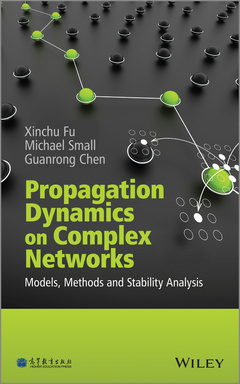Propagation Dynamics on Complex Networks Models, Methods and Stability Analysis
Auteurs : Fu Xinchu, Small Michael, Chen Guanrong

Explores the emerging subject of epidemic dynamics on complex networks, including theories, methods, and real-world applications
Throughout history epidemic diseases have presented a serious threat to human life, and in recent years the spread of infectious diseases such as dengue, malaria, HIV, and SARS has captured global attention; and in the modern technological age, the proliferation of virus attacks on the Internet highlights the emergent need for knowledge about modeling, analysis, and control in epidemic dynamics on complex networks.
For advancement of techniques, it has become clear that more fundamental knowledge will be needed in mathematical and numerical context about how epidemic dynamical networks can be modelled, analyzed, and controlled. This book explores recent progress in these topics and looks at issues relating to various epidemic systems.
Propagation Dynamics on Complex Networks covers most key topics in the field, and will provide a valuable resource for graduate students and researchers interested in network science and dynamical systems, and related interdisciplinary fields.
Key Features:
- Includes a brief history of mathematical epidemiology and epidemic modeling on complex networks.
- Explores how information, opinion, and rumor spread via the Internet and social networks.
- Presents plausible models for propagation of SARS and avian influenza outbreaks, providing a reality check for otherwise abstract mathematical modeling.
- Considers various infectivity functions, including constant, piecewise-linear, saturated, and nonlinear cases.
Examines information transmission on complex networks, and investigates the difference between information and epidemic spreading.
Preface xi
Summary xiii
1 Introduction 1
1.1 Motivation and background 1
1.2 A brief history of mathematical epidemiology 2
1.3 Organization of the book 5
References 6
2 Various epidemic models on complex networks 10
2.1 Multiple stage models 10
2.2 Staged progression models 13
2.3 Stochastic SIS model 17
2.4 Models with population mobility 19
2.5 Models in meta-populations 22
2.6 Models with effective contacts 24
2.7 Models with two distinct routes 26
2.8 Models with competing strains 28
2.9 Models with competing strains and saturated infectivity 31
2.10 Models with birth and death of nodes and links 33
2.11 Models on weighted networks 34
2.12 Models on directed networks 38
2.13 Models on colored networks 40
2.14 Discrete epidemic models 44
References 47
3 Epidemic threshold analysis 53
3.1 Threshold analysis by the direct method 53
3.2 Epidemic spreading efficiency threshold and epidemic threshold 69
3.3 Epidemic thresholds and basic reproduction numbers 76
References 98
4 Networked models for SARS and avian influenza 101
4.1 Network models of real diseases 101
4.2 Plausible models for propagation of the SARS virus 102
4.3 Clustering model for SARS transmission: Application to epidemic control and risk assessment 108
4.4 Small-world and scale-free models for SARS transmission 114
4.5 Super-spreaders and the rate of transmission 118
4.6 Scale-free distribution of avian influenza outbreaks 124
4.7 Stratified model of ordinary influenza 130
References 136
5 Infectivity functions 139
5.1 A model with nontrivial infectivity function 140
5.2 Saturated infectivity 143
5.3 Nonlinear infectivity for SIS model on scale-free networks 143
References 148
6 SIS models with an infective medium 150
6.1 SIS model with an infective medium 150
6.2 A modified SIS model with an infective medium 159
6.3 Epidemic models with vectors between two separated networks 162
6.4 Epidemic transmission on interdependent networks 167
6.4.1 Theoretical modeling 168
6.5 Discussions and remarks 179
References 181
7 Epidemic control and awareness 184
7.1 SIS model with awareness 184
7.2 Discrete-time SIS model with awareness 192
7.3 Spreading dynamics of a disease-awareness SIS model on complex networks 198
7.4 Remarks and discussions 201
References 203
8 Adaptive mechanism between dynamics and epidemics 207
8.1 Adaptive mechanism between dynamical synchronization and epidemic behavior on complex networks 207
8.2 Interplay between collective behavior and spreading dynamics 216
References 228
9 Epidemic control and immunization 231
9.1 SIS model with immunization 231
9.2 Edge targeted strategy for controlling epidemic spreading on scale-free networks 235
9.3 Remarks and discussions 237
References 239
10 Global stability analysis 240
10.1 Global stability analysis of the modified model with an infective medium 240
10.2 Global dynamics of the model with vectors between two separated networks 241
10.3 Global behavior of disease transmission on interdependent networks 247
10.4 Global behavior of epidemic transmissions 250
10.5 Global attractivity of a network-based epidemic SIS model 260
10.6 Global stability of an epidemic model with birth and death and adaptive weights 264
10.7 Global dynamics of a generalized epidemic model 268
References 274
11 Information diffusion and pathogen propagation 277
11.1 Information diffusion and propagation on complex networks 277
11.2 Interplay between information of disease spreading and epidemic dynamics 281
11.3 Discussions and remarks 284
References 286
Appendix A Proofs of theorems 289
A.1 Transition from discrete-time linear system to continuous-time linear system 289
A.2 Proof of Lemma 6.1 291
A.3 Proof of Theorem 10.4 291
A.4 Proof of Theorem 10.3 292
A.5 Proof of Theorem 10.42 296
Appendix B Further proofs of results 302
B.1 Eigenvalues of the matrix Þ F in (6.27) 302
B.2 The matrix 𝛤 in (6.32) 304
B.3 Proof of (7.6) in Chapter 7 305
B.4 The positiveness of 𝜎′: proof of 𝜎′ > 0 in Section 9.1.2 306
B.5 The relation between 𝛬 and 𝜅 in Section 9.1.3 308
Index 311
Xinchu Fu, Department of Mathematics, Shanghai University, China
Michael Small, School of Mathematics and Statistics, The University of Western Australia, Australia
Guanrong Chen, Department of Electronic Engineering, City University of Hong Kong, China
Date de parution : 02-2014
Ouvrage de 328 p.
15.8x23.6 cm


